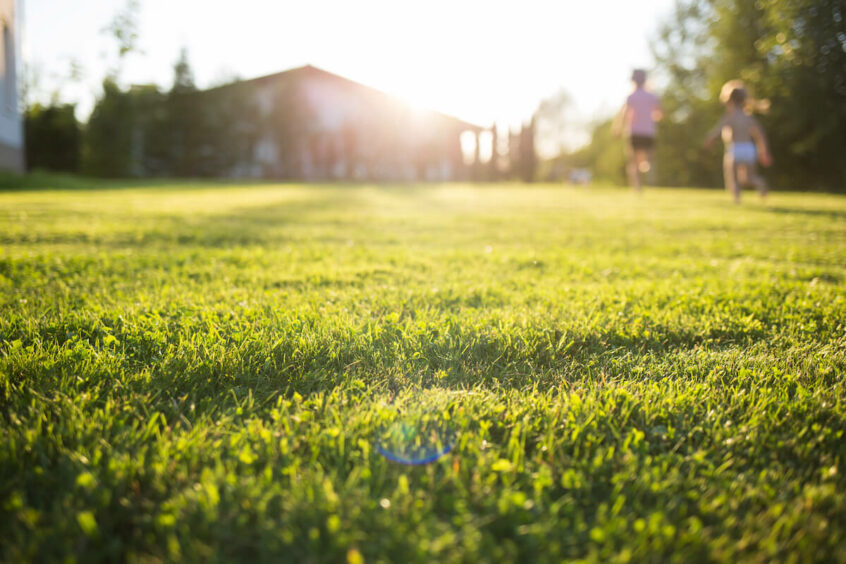Last month we talked about heat stress in cool season lawns. It’s to be expected that grasses meant to grow in cooler climates would struggle in the southern summer heat, but that doesn’t make it any less frustrating. Fescue grass and Kentucky Bluegrass can take a lot of time, attention, and money to keep healthy in hotter climates. During a heat wave, it can seem nearly impossible to keep them green and lush. That’s why so many homeowners in the South choose to make the switch to warm-season lawns.
It’s important to note that while warm-season grasses like Zoysia and Bermuda are resistant to heat stress, they aren’t immune. In extreme heat or during prolonged hot weather, even hardy grasses like these can show signs of heat stress. Below we cover some simple care steps on taking care of heat stress in warm season lawns.
Caring for Heat Stress in Warm Season Lawns
WATERING
Bermuda and Zoysia grasses thrive in warm weather. These heat-loving grasses grow actively from April to October in the Southeast. Ground temperatures of 65 degrees Fahrenheit and above encourage active growth in these varieties! When you combine the warm weather with an appropriate watering schedule, Zoysia and Bermuda grasses are really able to take off.
Here in Georgia, we can usually expect rain at LEAST once a week in the late summer. However, it’s important not to rely on the weather 100% for your lawn’s water supply. This is doubly true if you’re in a dryer state where rain isn’t a guarantee. The most important thing to know about having a warm season lawn is this: it is NOT GOOD to allow these lawns to experience heat dormancy. Cool-season grasses can handle dormancy in the summer. That’s because their growth cycles happen in the Spring and Fall. Green lawns in the Summer aren’t a guarantee for these cool-season grasses, but a bonus.
The opposite is true for warm-season grasses. Zoysia and Bermuda need all the energy they can get from the summer sun. This season is the optimal time for new runners and shoots, healthy green blades, and deepening root systems. If they’re allowed to go dormant, these warm-season grasses become susceptible to thinning out which can cause bare patches. That in turn creates optimal conditions for weeds to crop up and take over.
No need to worry, though! Just make sure your lawn has sufficient water to make it through the heat spell. Your lawn should be getting 1/2 an inch every 2-3 days. If that isn’t enough water to hold off heat stress, shoot for 3/4 of an inch instead.
FERTILIZING
Late summer and early are a great time to apply one last round of slow-release fertilizer to your warm-season lawn before the weather cools off. Applying now allows your lawn to start storing energy for its slower seasons, winter and spring. Here are our recommendations for late summer and fall fertilizers.
Slow-release formulations especially are an excellent idea for the end of the season. Milorganite can feed your lawn for up to 10 weeks. That means that applying now will get your yard well into the Fall before you need to apply again. The balance of iron and nitrogen helps promote steady growth during the warm growing season.
This formula that provides a deep green lawn without the excessive growth that some nitrogen-rich fertilizers can cause. While nitrogen causes greening and growth, iron provides greening without the growth surges. To deliver lawn care results that truly exceed your expectations, this product has been enhanced with beneficial microbes and advanced soil technology.
Lawnifi Fall Fertilizer Box (Liquid):
This fertilizer box has 3 different formulas. One is to boost your lawn, one to maintain, and one to aid in recovery. We highly recommend this product for Bermuda grasses and other warm-season lawns. The online Lawnifi shop also carries individual bottles of their different products, though we love the box option because you’ll always have different formulations on hand depending on what your lawn needs.
A 19-19-19 fertilizer is 19% nitrogen, 19% potassium, and 19% phosphorous. While typically used for flowers or veggies, triple 19 fertilizers can also be used on lawns. Each of these key nutrients packs plenty of benefits for growing plants. Nitrogen helps give grass a vibrant green color and encourages growth. Potassium can help plants become more resistant to diseases, meaning your lawn won’t get sick so easily. Finally, phosphorous promotes new root formation.
Make the Switch to a Warm Season Lawn
If you’re living in a warmer climate, it’s well worth it to make the switch to a warm-season lawn. Not only are Zoysia and Bermuda grasses more resistant to heat stress, they actually thrive in hot weather as long as their watering and fertilizing needs are met. Depending on where you live, you can expect to get vibrant and lush green grass for more than half the year with a warm-season grass.
If you’re concerned about the logistics of laying down new sod as we head into the fall and winter, don’t worry! Realistically, you can lay down new sod any time of year as long as you know how to take proper care of it season-by-season. Check out our next post coming later this month on fall lawn care tips.
